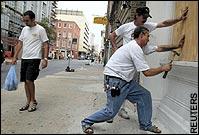 W
With images of homes in the south under water, thoughts turn to flood mapping. Flood insurance in the U.S. is administered through the
National Flood Insurance Program, a division of the
Federal Emergency Management Agency (FEMA). In order to assess the risk of flooding for a particular piece of property, FEMA prepares Flood Insurance Rate Maps. These maps depict a shaded area which it is estimated flood waters will rise to. These maps vary greatly in precision and detail. FEMA is currently attempting to
modernize its flood maps, replacing its old paper maps with web-based maps.
One issue that arises is that not everyone is happy to have new, more modern maps. The new maps can stir up controversy when they depict property in the
100 year flood plain that had previously not been depicted in the flood plain.
Residents of New Hampshire have complained about what they consider the needless expense of buying flood insurance when they previously have done without. Federal law requires the lienholder of real property to require the property owner to obtain flood insurance if the property lies in the flood plain. Lenders take advantage of the new, modern maps, sending out letters to their mortgagees, instructing them that they must obtain flood insurance. Of course, new, more accurate maps can also determine that property that was previously believed susceptible to flooding is not. Such is the case in
North Platte Nebraska, where modern mapping has removed a large section of the city from the 100 year flood plain, saving property owners money.
For those that are curious as to whether their homes are in the flood plain or not, FEMA offers scanned versions of their existing paper maps at their
Flood Map Store. However, you do not have to purchase the entire map. There is an option to view the map, from which you can print a "Firmette", essentially a small section of the flood map.
 Add South Korea to the list of foreign governments expressing concerns about Google Earth, the new online mapping program from Google. A story in the International Herald Tribune, quotes presidential spokesman Kim Man Soo, as saying that Seoul plans to raise its concerns about the service with the United States in the next few days. Among their concerns are the fact that the Blue House, the presidential palace, as well as images of South Korean military bases are clearly visible on the service. Technically, the country is still at war with its neighbor to the north. North Korea has raised concerns worldwide by pursuing the development of nuclear weapons.
Add South Korea to the list of foreign governments expressing concerns about Google Earth, the new online mapping program from Google. A story in the International Herald Tribune, quotes presidential spokesman Kim Man Soo, as saying that Seoul plans to raise its concerns about the service with the United States in the next few days. Among their concerns are the fact that the Blue House, the presidential palace, as well as images of South Korean military bases are clearly visible on the service. Technically, the country is still at war with its neighbor to the north. North Korea has raised concerns worldwide by pursuing the development of nuclear weapons.

















